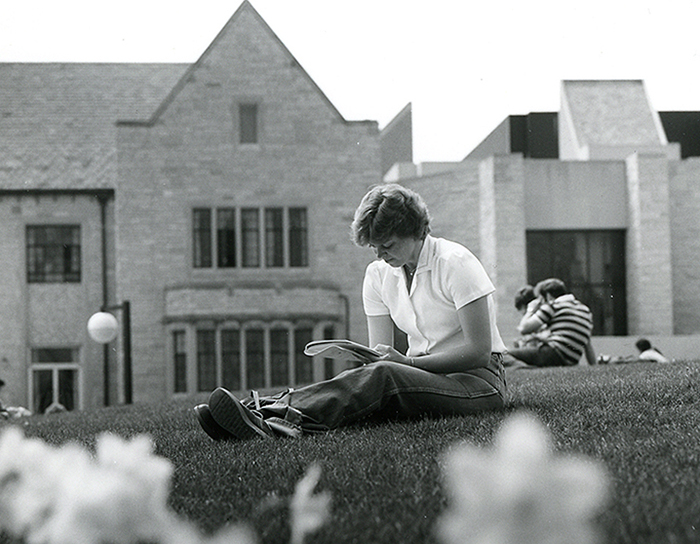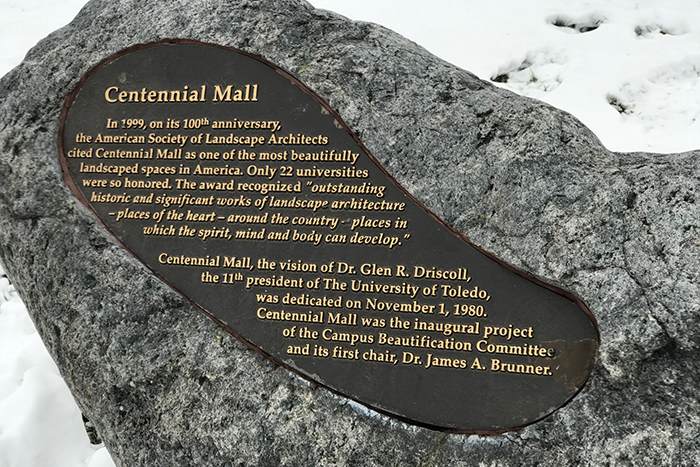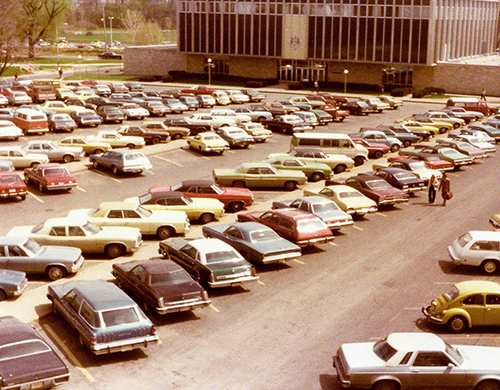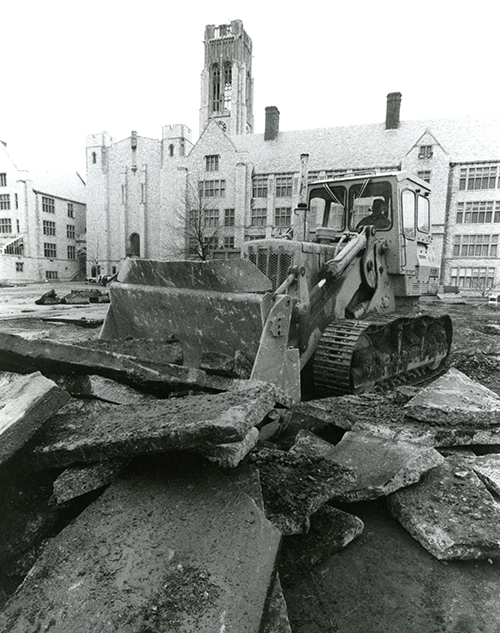UT’s own little piece of paradise
Beautification Committee brings Centennial Mall to fruition
By Laurie B. Davis
“Don’t it always seem to go, that you don’t know what you’ve got ’til it’s gone; they pave paradise and put up a parking lot.”
In the 1970s, Joni Mitchell’s popular folk song bemoaned the loss of green spaces for the sake of commercial progress, as she sang about putting the trees in a museum and charging people to see them.
Driscoll’s vision was the very opposite of Mitchell’s chorus; he wanted to raze a parking lot and put up UT’s own version of a little paradise, what’s known today as Centennial Mall.
Driscoll enlisted the help of business professor Dr. James Brunner to form a beautification committee and begin the process of turning a parking lot behind University Hall into a space with flowers, grass and trees, a place of natural beauty where students could gather to study or just meet up with friends.Richard Eastop, a former dean of Admissions, remembers how Driscoll’s proposition played out. “One day, Glenn called Jim into his office. Jim didn’t know what he was going in there for, and Glenn said, ‘I hear you’re a professor who likes to dig in the dirt.’ Jim said, ‘well, yes, I like flowers, I like trees.’ Glenn said, ‘I have a mission for you. I would like to make our back door as nice as our front door.’”
Eastop joined Brunner’s Beautification Committee and later succeeded Brunner as the committee’s chair. “At that time, I was the dean of Admissions, and you know how important a nice campus is to attracting students, so I had a hidden agenda. The better we could make the campus look, the better my people could recruit students to come here,” says Eastop.

park-like setting as a place to read, relax and gather between classes.
 He says when word got out and the faculty and staff learned of the new plan for a mall, there was a “minor rebellion.” No one wanted to lose their parking space close to the buildings in which they worked. Eastop says he and Brunner advised Driscoll that he’d “take a lot of heat over this,” but Driscoll’s strong resolve pushed the project through.
He says when word got out and the faculty and staff learned of the new plan for a mall, there was a “minor rebellion.” No one wanted to lose their parking space close to the buildings in which they worked. Eastop says he and Brunner advised Driscoll that he’d “take a lot of heat over this,” but Driscoll’s strong resolve pushed the project through.
Eleanor (Ellie) Brunner, wife of the late James Brunner, says, “I told Jim, stick to your guns. They’ll come around,” referring to the naysayers.
 And they did. “If it’s always been there, it should always be there. People were resistant to change,” Brunner says. “After it was done, you would have thought they had a part in it. They loved it after it took shape and form,” says Brunner.
And they did. “If it’s always been there, it should always be there. People were resistant to change,” Brunner says. “After it was done, you would have thought they had a part in it. They loved it after it took shape and form,” says Brunner.
Centennial Mall’s evolution
The view from above Centennial Mall, as seen in aerial photographs and illustrated maps, reveals a circular walkway connected to side paths, making the center of the mall look like a wheel with spokes. As the story goes, those paths came into existence when a handful of UT students mapped them out.
Eastop recalls what he remembers about the sidewalk design. “It could be an urban legend, but supposedly, and I’ve met some students who will swear to it, after a snowfall over a weekend, when not many cars were in the parking lot, a couple of geography or geology students, for the heck of it, kind of mapped out where students were walking across the snow. As you see the sidewalks today in Centennial Mall, that’s where those students’ footprints were. They gave it to Dr. Brunner, and he liked the idea.”Ellie Brunner says she told her husband that was a brainy idea and they should include those pathways familiar to students. And they did.

Dr. Steven LeBlanc (Eng ’76), former interim dean of the College of Engineering and now a retired faculty member, chaired the Beautification Committee beginning in 2001, after a hiatus for the group. LeBlanc says the committee consults University leaders on new building construction and landscaping projects.
LeBlanc says the committee’s sculpture program is coordinated through Midwest Sculpture Initiative, which puts out calls to the artists. About a dozen sculptures have been purchased by entities on campus or by other individuals who then donated the pieces to campus, including “The Gardener.” “‘The Gardener’ is intended to be Jim Brunner; it was in the show and then purchased and donated,” says LeBlanc. There’s another one called “Thinker” that someone purchased and wanted to dedicate to a professor he had years ago. We’ve increased our permanent collection quite a bit from those,” LeBlanc says.
LeBlanc recalls the creation of the Ravin Plaza in the center of the mall, which included providing the University seal with a proper presentation. “The seal was on the ground and it would get dirt and water on it as people would walk on it. We didn’t think that was very respectful of the University seal. As part of that renovation, we wanted to raise that seal. Gardens were installed in the center at that time, as were new concrete and benches.” Ravin Plaza was dedicated in July 2004 in honor of Dr. Louis and Mrs. Sophie Ravin. Today, Centennial Mall is the heart of campus and a place of community spirit. President Sharon L. Gaber has honored the space by making it a place of welcoming, through events specifically designed for her to meet and interact with students. Every year, students hold their own events on Centennial Mall, and each summer, the Alumni Association presents its annual Art on the Mall juried art fair. And of course, when the weather is warm and sunny, students lounge on the lawns, just as students from decades past have done.Both Driscoll and James Brunner would be proud to see how Centennial Mall has evolved over the years to become more than a pretty backyard for the buildings that surround it. They might have said, “sometimes, you don’t know what you’ll get ’til it’s done.”
… Oooo, bop, bop, bop, bop.
















